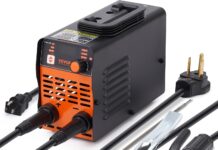In the world of welding, AC and DC are like the yin and yang, two sides of the same coin. Both have their unique characteristics and specific applications. AC welding, short for Alternating Current welding, is known for its versatility and ability to weld a wide range of materials. On the other hand, DC welding, which stands for Direct Current welding, is preferred for its powerful and consistent arc. Stay tuned as we embark on a journey to explore the differences between AC and DC welding techniques.
Introduction
Welcome to our comprehensive guide on AC and DC welding! In this article, we will explore the basic definitions, advantages, and disadvantages of both AC welding and DC welding. We will also compare these two welding methods in terms of current type, power supply, welding process, electrode types, and welding applications. Furthermore, we will delve into the details of AC welding and DC welding, including how they work, the necessary equipment, and the techniques involved. Finally, we will discuss the advantages and disadvantages of both AC and DC welding, highlighting their unique characteristics. So, let’s dive in and discover the fascinating world of AC and DC welding!
Basic Introduction to AC Welding
Definition of AC Welding
AC welding stands for Alternating Current Welding. In this method, the welding current alternates between positive and negative currents, changing direction periodically. This continuous reversal of current flow creates a versatile welding process that enables the joining of various metal materials.
Advantages of AC Welding
AC welding offers several advantages. First and foremost, it allows for the welding of different types of metals, making it highly versatile. Additionally, it is particularly suitable for welding thin materials as it reduces the risk of burn-through. AC welding also requires lower initial costs compared to DC welding, making it a more accessible option for beginners or those on a budget.
Disadvantages of AC Welding
Despite its advantages, AC welding also has its share of disadvantages. One major drawback is the lack of control over the heat input. The continuous alteration of current direction leads to fluctuations in heat, making it challenging to maintain consistent temperatures. Another potential issue is the possibility of arc instabilities, which can affect the overall welding quality. Lastly, AC welding has limited penetration capability, meaning it may not be suitable for thicker materials or certain types of welding applications.
Basic Introduction to DC Welding
Definition of DC Welding
DC welding, on the other hand, refers to Direct Current Welding. Unlike AC welding, the current in DC welding flows steadily in one direction without reversing. This stable and continuous current flow provides certain benefits in the welding process.
Advantages of DC Welding
DC welding offers several advantages over AC welding. One key advantage is its superior control over heat input. The constant direction of current allows for precise adjustments in the welding parameters, resulting in better control over temperature and overall welding quality. DC welding also ensures stable arc characteristics, minimizing the risks of arc instabilities or spattering. Furthermore, it provides higher penetration capability, making it suitable for welding thicker materials and achieving deeper welds.
Disadvantages of DC Welding
Despite its advantages, DC welding does have a few disadvantages. One limitation is its compatibility with a narrower range of metals compared to AC welding. It may not be as versatile when it comes to welding dissimilar metals. Additionally, DC welding generally requires more expensive equipment compared to AC welding, which may be a factor to consider for those on a tight budget.
Comparison of AC and DC Welding
Difference in Current Type
The primary difference between AC and DC welding lies in the nature of the current used. AC welding utilizes alternating current, which periodically changes direction, while DC welding employs direct current flowing steadily in one direction.
Difference in Power Supply
AC welding typically requires an AC power supply, which is the standard electrical supply from the utility grid. On the other hand, DC welding can be powered by either an AC or a DC power supply, offering more flexibility in terms of equipment requirements.
Difference in Welding Process
The welding process also differs between AC and DC welding. AC welding allows for a versatile welding process suitable for a wide range of metals, while DC welding provides better control and stability during the welding process.
Difference in Electrode Types
The choice of electrode types also varies between AC and DC welding. AC welding commonly uses electrodes with a slightly thicker coating, while DC welding often utilizes electrodes with a thinner coating that enables better control over the welding process.
Difference in Welding Applications
AC welding is often employed in applications where versatility is crucial, such as in the welding of dissimilar metals or thin materials. DC welding, on the other hand, finds its niche in applications requiring more control, stability, and penetration capability, such as welding thicker materials or achieving deep welds.
AC Welding in Detail
How AC Welding Works
In AC welding, the welding current is generated by an AC power source and flows back and forth, reversing its direction periodically. This continuous change in current polarity allows for versatile welding as it prevents the excessive build-up of heat and reduces the risk of burn-through, especially on thinner materials.
AC Welding Equipment
To perform AC welding, you will need a welding machine capable of generating alternating current. These machines come with a range of features and capabilities to ensure precise control of the welding process. Additionally, a suitable electrode, welding cables, and safety equipment such as gloves and a welding helmet are essential.
AC Welding Techniques
AC welding techniques can vary depending on the specific application and material being welded. However, some common techniques include the use of a weaving motion or a circular motion to distribute the heat evenly while maintaining a stable arc. Additionally, adjusting the amperage and travel speed can help achieve the desired penetration and welding quality.
DC Welding in Detail
How DC Welding Works
DC welding operates by producing a direct current that flows steadily in one direction, either positive or negative. This stable and continuous current enables precise control over the welding process and consistent heat output, resulting in improved welding quality and stability.
DC Welding Equipment
To perform DC welding, you will need a welding machine capable of generating direct current. These machines may offer additional features such as adjustable voltage, amperage control, and built-in safety mechanisms. In addition to the welding machine, you will also require suitable electrodes, welding cables, and safety gear.
DC Welding Techniques
DC welding techniques involve maintaining a stable arc and controlling the heat input. Techniques such as dragging or pushing the electrode, maintaining the correct arc length, and adjusting the welding parameters based on the specific material and welding position are crucial for achieving optimal results.
Advantages of AC Welding
Versatility in Welding Metals
One significant advantage of AC welding is its versatility when it comes to welding different types of metals. The alternating current allows for successful welds between various materials, including dissimilar metals. This versatility makes AC welding a popular choice in industries where the joining of different metals is common.
Suitability for Thin Materials
AC welding is particularly suitable for welding thin materials. The alternating current helps prevent excessive heat buildup, reducing the risk of burn-through and warping. This makes it an excellent option for applications involving sheet metal, thin pipes, or delicate components that require precision while maintaining the integrity of the material.
Lower Initial Costs
Compared to DC welding, AC welding generally requires lower initial costs. AC welding machines and equipment are often more affordable, making it an attractive option for beginners or hobbyists who are just starting their welding journey. The accessibility and affordability of AC welding equipment allow individuals to explore the world of welding without breaking the bank.
Disadvantages of AC Welding
Less Control over Heat Input
One of the primary disadvantages of AC welding is the limited control over heat input. The continuous reversal of the current’s direction makes it challenging to maintain consistent temperatures, especially when compared to DC welding. This lack of control can result in inconsistent weld quality and potentially lead to issues such as improper penetration or weak welds.
Possible Arc Instabilities
AC welding may also be prone to arc instabilities. These instabilities can disrupt the welding process, leading to inconsistencies in the weld bead and overall quality. While proper welding techniques and equipment can minimize this risk, it is essential to be aware of potential arc instability issues when using AC welding.
Limited Penetration Capability
AC welding may have limited penetration capability compared to DC welding. In applications where deep weld penetration is required, AC welding may not be the most suitable option. Other welding methods, such as DC welding or specialized techniques, may be necessary to achieve the desired depth and strength in the weld joint.
Advantages of DC Welding
Better Control over Heat Input
DC welding provides superior control over heat input compared to AC welding. The steady flow of current in one direction allows for precise adjustments in welding parameters, resulting in consistent heat output. This enhanced control enables welders to achieve desired penetration depth, control the weld pool, and produce high-quality welds.
Stable Arc Characteristics
DC welding offers stable arc characteristics, which are crucial for maintaining a consistent welding process. The continuous flow of current in one direction reduces the risk of arc fluctuations and spattering. This stability ensures a smoother and more controlled welding experience, resulting in improved weld quality and reduced rework.
Higher Penetration Capability
Thanks to its stable current flow, DC welding provides higher penetration capability compared to AC welding. This makes it a preferred choice in applications involving thicker materials or joints that require deep weld penetration. The increased penetration capability of DC welding allows for stronger, more reliable welds in a wide range of applications.
Conclusion
In conclusion, both AC welding and DC welding have their unique characteristics and advantages. AC welding offers versatility in welding metals, suitability for thin materials, and lower initial costs. However, it lacks control over heat input, may experience arc instabilities, and has limited penetration capability. On the other hand, DC welding provides better control over heat input, stable arc characteristics, and higher penetration capability. While it may have a narrower range of applications and higher equipment costs, these factors are outweighed by the desirable welding qualities it offers. Ultimately, the choice between AC and DC welding depends on the specific welding requirements, materials being welded, and the skill level of the welder. By understanding the differences and considering the advantages and disadvantages of each method, welders can make informed decisions to achieve optimal results in their welding projects. So, whether you choose AC welding or DC welding, it’s time to put on your welding helmet, grab your electrode, and let your creativity fuse metal together with the power of electricity!






































